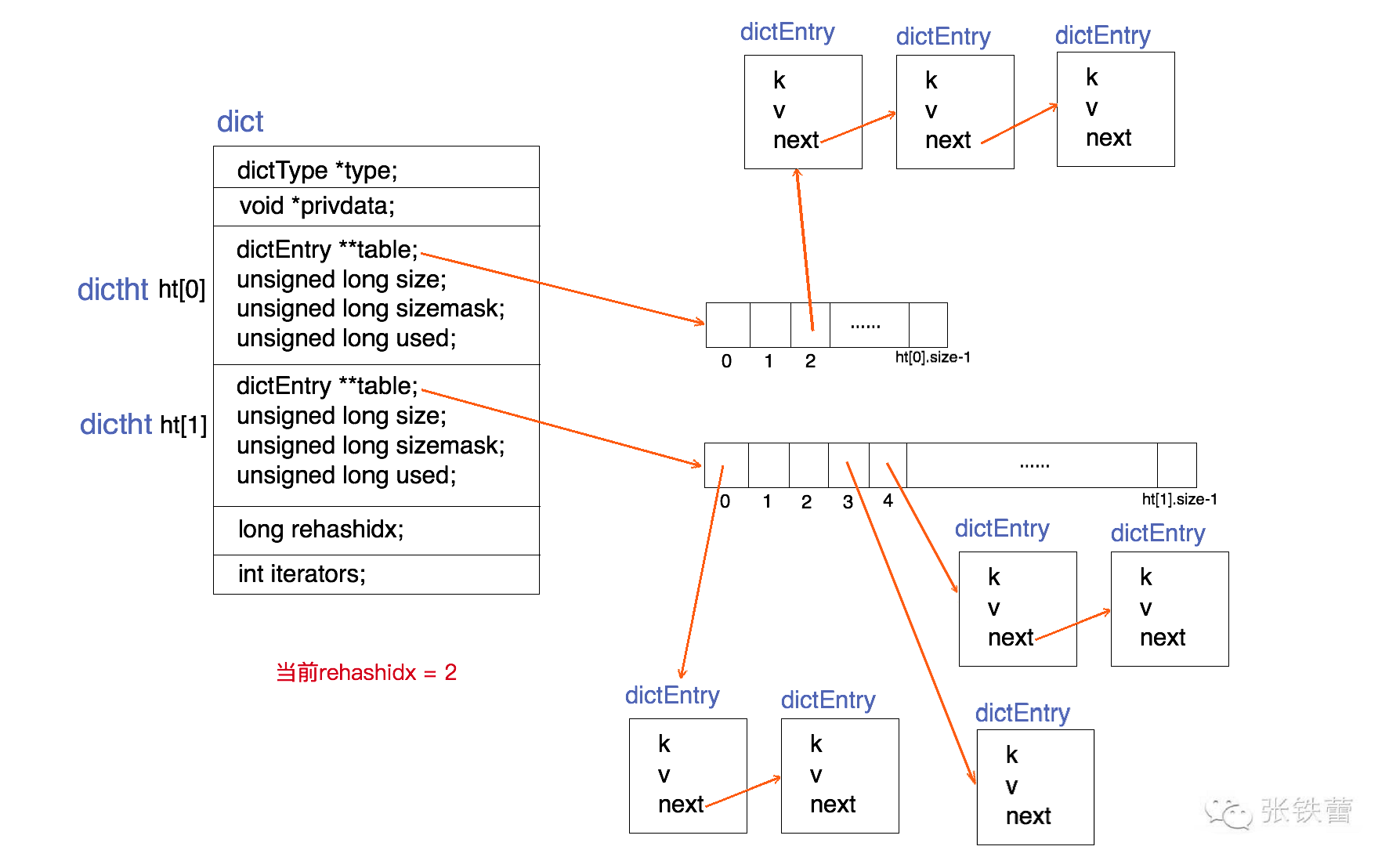您好,登录后才能下订单哦!
本篇文章为大家展示了Redis中内部数据结构dict的作用是什么,内容简明扼要并且容易理解,绝对能使你眼前一亮,通过这篇文章的详细介绍希望你能有所收获。
dict的数据结构定义
为了实现增量式重哈希(incremental rehashing),dict的数据结构里包含两个哈希表。在重哈希期间,数据从第一个哈希表向第二个哈希表迁移。
dict的C代码定义如下(出自Redis源码dict.h):
typedef struct dictEntry {
void *key;
union {
void *val;
uint64_t u64;
int64_t s64;
double d;
} v;
struct dictEntry *next;
} dictEntry;
typedef struct dictType {
unsigned int (*hashFunction)(const void *key);
void *(*keyDup)(void *privdata, const void *key);
void *(*valDup)(void *privdata, const void *obj);
int (*keyCompare)(void *privdata, const void *key1, const void *key2);
void (*keyDestructor)(void *privdata, void *key);
void (*valDestructor)(void *privdata, void *obj);
} dictType;
/* This is our hash table structure. Every dictionary has two of this as we
* implement incremental rehashing, for the old to the new table. */
typedef struct dictht {
dictEntry **table;
unsigned long size;
unsigned long sizemask;
unsigned long used;
} dictht;
typedef struct dict {
dictType *type;
void *privdata;
dictht ht[2];
long rehashidx; /* rehashing not in progress if rehashidx == -1 */
int iterators; /* number of iterators currently running */
} dict;为了能更清楚地展示dict的数据结构定义,我们用一张结构图来表示它。如下。

结合上面的代码和结构图,可以很清楚地看出dict的结构。一个dict由如下若干项组成:
一个指向dictType结构的指针(type)。它通过自定义的方式使得dict的key和value能够存储任何类型的数据。
一个私有数据指针(privdata)。由调用者在创建dict的时候传进来。
两个哈希表(ht[2])。只有在重哈希的过程中,ht[0]和ht[1]才都有效。而在平常情况下,只有ht[0]有效,ht[1]里面没有任何数据。上图表示的就是重哈希进行到中间某一步时的情况。
当前重哈希索引(rehashidx)。如果rehashidx = -1,表示当前没有在重哈希过程中;否则,表示当前正在进行重哈希,且它的值记录了当前重哈希进行到哪一步了。
当前正在进行遍历的iterator的个数。这不是我们现在讨论的重点,暂时忽略。
dictType结构包含若干函数指针,用于dict的调用者对涉及key和value的各种操作进行自定义。这些操作包含:
hashFunction,对key进行哈希值计算的哈希算法。
keyDup和valDup,分别定义key和value的拷贝函数,用于在需要的时候对key和value进行深拷贝,而不仅仅是传递对象指针。
keyCompare,定义两个key的比较操作,在根据key进行查找时会用到。
keyDestructor和valDestructor,分别定义对key和value的析构函数。
私有数据指针(privdata)就是在dictType的某些操作被调用时会传回给调用者。
需要详细察看的是dictht结构。它定义一个哈希表的结构,由如下若干项组成:
一个dictEntry指针数组(table)。key的哈希值最终映射到这个数组的某个位置上(对应一个bucket)。如果多个key映射到同一个位置,就发生了冲突,那么就拉出一个dictEntry链表。
size:标识dictEntry指针数组的长度。它总是2的指数。
sizemask:用于将哈希值映射到table的位置索引。它的值等于(size-1),比如7, 15, 31, 63,等等,也就是用二进制表示的各个bit全1的数字。每个key先经过hashFunction计算得到一个哈希值,然后计算(哈希值 & sizemask)得到在table上的位置。相当于计算取余(哈希值 % size)。
used:记录dict中现有的数据个数。它与size的比值就是装载因子(load factor)。这个比值越大,哈希值冲突概率越高。
dictEntry结构中包含k, v和指向链表下一项的next指针。k是void指针,这意味着它可以指向任何类型。v是个union,当它的值是uint64_t、int64_t或double类型时,就不再需要额外的存储,这有利于减少内存碎片。当然,v也可以是void指针,以便能存储任何类型的数据。
dict *dictCreate(dictType *type,
void *privDataPtr)
{
dict *d = zmalloc(sizeof(*d));
_dictInit(d,type,privDataPtr);
return d;
}
int _dictInit(dict *d, dictType *type,
void *privDataPtr)
{
_dictReset(&d->ht[0]);
_dictReset(&d->ht[1]);
d->type = type;
d->privdata = privDataPtr;
d->rehashidx = -1;
d->iterators = 0;
return DICT_OK;
}
static void _dictReset(dictht *ht)
{
ht->table = NULL;
ht->size = 0;
ht->sizemask = 0;
ht->used = 0;
}dictCreate为dict的数据结构分配空间并为各个变量赋初值。其中两个哈希表ht[0]和ht[1]起始都没有分配空间,table指针都赋为NULL。这意味着要等第一个数据插入时才会真正分配空间。
#define dictIsRehashing(d) ((d)->rehashidx != -1)
dictEntry *dictFind(dict *d, const void *key)
{
dictEntry *he;
unsigned int h, idx, table;
if (d->ht[0].used + d->ht[1].used == 0) return NULL; /* dict is empty */
if (dictIsRehashing(d)) _dictRehashStep(d);
h = dictHashKey(d, key);
for (table = 0; table <= 1; table++) {
idx = h & d->ht[table].sizemask;
he = d->ht[table].table[idx];
while(he) {
if (key==he->key || dictCompareKeys(d, key, he->key))
return he;
he = he->next;
}
if (!dictIsRehashing(d)) return NULL;
}
return NULL;
}上述dictFind的源码,根据dict当前是否正在重哈希,依次做了这么几件事:
如果当前正在进行重哈希,那么将重哈希过程向前推进一步(即调用_dictRehashStep)。实际上,除了查找,插入和删除也都会触发这一动作。这就将重哈希过程分散到各个查找、插入和删除操作中去了,而不是集中在某一个操作中一次性做完。
计算key的哈希值(调用dictHashKey,里面的实现会调用前面提到的hashFunction)。
先在第一个哈希表ht[0]上进行查找。在table数组上定位到哈希值对应的位置(如前所述,通过哈希值与sizemask进行按位与),然后在对应的dictEntry链表上进行查找。查找的时候需要对key进行比较,这时候调用dictCompareKeys,它里面的实现会调用到前面提到的keyCompare。如果找到就返回该项。否则,进行下一步。
判断当前是否在重哈希,如果没有,那么在ht[0]上的查找结果就是最终结果(没找到,返回NULL)。否则,在ht[1]上进行查找(过程与上一步相同)。
下面我们有必要看一下增量式重哈希的_dictRehashStep的实现。
static void _dictRehashStep(dict *d) {
if (d->iterators == 0) dictRehash(d,1);
}
int dictRehash(dict *d, int n) {
int empty_visits = n*10; /* Max number of empty buckets to visit. */
if (!dictIsRehashing(d)) return 0;
while(n-- && d->ht[0].used != 0) {
dictEntry *de, *nextde;
/* Note that rehashidx can't overflow as we are sure there are more
* elements because ht[0].used != 0 */
assert(d->ht[0].size > (unsigned long)d->rehashidx);
while(d->ht[0].table[d->rehashidx] == NULL) {
d->rehashidx++;
if (--empty_visits == 0) return 1;
}
de = d->ht[0].table[d->rehashidx];
/* Move all the keys in this bucket from the old to the new hash HT */
while(de) {
unsigned int h;
nextde = de->next;
/* Get the index in the new hash table */
h = dictHashKey(d, de->key) & d->ht[1].sizemask;
de->next = d->ht[1].table[h];
d->ht[1].table[h] = de;
d->ht[0].used--;
d->ht[1].used++;
de = nextde;
}
d->ht[0].table[d->rehashidx] = NULL;
d->rehashidx++;
}
/* Check if we already rehashed the whole table... */
if (d->ht[0].used == 0) {
zfree(d->ht[0].table);
d->ht[0] = d->ht[1];
_dictReset(&d->ht[1]);
d->rehashidx = -1;
return 0;
}
/* More to rehash... */
return 1;
}dictRehash每次将重哈希至少向前推进n步(除非不到n步整个重哈希就结束了),每一步都将ht[0]上某一个bucket(即一个dictEntry链表)上的每一个dictEntry移动到ht[1]上,它在ht[1]上的新位置根据ht[1]的sizemask进行重新计算。rehashidx记录了当前尚未迁移(有待迁移)的ht[0]的bucket位置。
如果dictRehash被调用的时候,rehashidx指向的bucket里一个dictEntry也没有,那么它就没有可迁移的数据。这时它尝试在ht[0].table数组中不断向后遍历,直到找到下一个存有数据的bucket位置。如果一直找不到,则最多走n*10步,本次重哈希暂告结束。
最后,如果ht[0]上的数据都迁移到ht[1]上了(即d->ht[0].used == 0),那么整个重哈希结束,ht[0]变成ht[1]的内容,而ht[1]重置为空。
根据以上对于重哈希过程的分析,我们容易看出,本文前面的dict结构图中所展示的正是rehashidx=2时的情况,前面两个bucket(ht[0].table[0]和ht[0].table[1])都已经迁移到ht[1]上去了。
dictAdd插入新的一对key和value,如果key已经存在,则插入失败。
dictReplace也是插入一对key和value,不过在key存在的时候,它会更新value。
int dictAdd(dict *d, void *key, void *val)
{
dictEntry *entry = dictAddRaw(d,key);
if (!entry) return DICT_ERR;
dictSetVal(d, entry, val);
return DICT_OK;
}
dictEntry *dictAddRaw(dict *d, void *key)
{
int index;
dictEntry *entry;
dictht *ht;
if (dictIsRehashing(d)) _dictRehashStep(d);
/* Get the index of the new element, or -1 if
* the element already exists. */
if ((index = _dictKeyIndex(d, key)) == -1)
return NULL;
/* Allocate the memory and store the new entry.
* Insert the element in top, with the assumption that in a database
* system it is more likely that recently added entries are accessed
* more frequently. */
ht = dictIsRehashing(d) ? &d->ht[1] : &d->ht[0];
entry = zmalloc(sizeof(*entry));
entry->next = ht->table[index];
ht->table[index] = entry;
ht->used++;
/* Set the hash entry fields. */
dictSetKey(d, entry, key);
return entry;
}
static int _dictKeyIndex(dict *d, const void *key)
{
unsigned int h, idx, table;
dictEntry *he;
/* Expand the hash table if needed */
if (_dictExpandIfNeeded(d) == DICT_ERR)
return -1;
/* Compute the key hash value */
h = dictHashKey(d, key);
for (table = 0; table <= 1; table++) {
idx = h & d->ht[table].sizemask;
/* Search if this slot does not already contain the given key */
he = d->ht[table].table[idx];
while(he) {
if (key==he->key || dictCompareKeys(d, key, he->key))
return -1;
he = he->next;
}
if (!dictIsRehashing(d)) break;
}
return idx;
}以上是dictAdd的关键实现代码。我们主要需要注意以下几点:
它也会触发推进一步重哈希(_dictRehashStep)。
如果正在重哈希中,它会把数据插入到ht[1];否则插入到ht[0]。
在对应的bucket中插入数据的时候,总是插入到dictEntry的头部。因为新数据接下来被访问的概率可能比较高,这样再次查找它时就比较次数较少。
_dictKeyIndex在dict中寻找插入位置。如果不在重哈希过程中,它只查找ht[0];否则查找ht[0]和ht[1]。
_dictKeyIndex可能触发dict内存扩展(_dictExpandIfNeeded,它将哈希表长度扩展为原来两倍,具体请参考dict.c中源码)。
dictReplace在dictAdd基础上实现,如下:
int dictReplace(dict *d, void *key, void *val)
{
dictEntry *entry, auxentry;
/* Try to add the element. If the key
* does not exists dictAdd will suceed. */
if (dictAdd(d, key, val) == DICT_OK)
return 1;
/* It already exists, get the entry */
entry = dictFind(d, key);
/* Set the new value and free the old one. Note that it is important
* to do that in this order, as the value may just be exactly the same
* as the previous one. In this context, think to reference counting,
* you want to increment (set), and then decrement (free), and not the
* reverse. */
auxentry = *entry;
dictSetVal(d, entry, val);
dictFreeVal(d, &auxentry);
return 0;
}在key已经存在的情况下,dictReplace会同时调用dictAdd和dictFind,这其实相当于两次查找过程。这里Redis的代码不够优化。
dictDelete的源码这里忽略,具体请参考dict.c。需要稍加注意的是:
dictDelete也会触发推进一步重哈希(_dictRehashStep)
如果当前不在重哈希过程中,它只在ht[0]中查找要删除的key;否则ht[0]和ht[1]它都要查找。
删除成功后会调用key和value的析构函数(keyDestructor和valDestructor)。
上述内容就是Redis中内部数据结构dict的作用是什么,你们学到知识或技能了吗?如果还想学到更多技能或者丰富自己的知识储备,欢迎关注亿速云行业资讯频道。
免责声明:本站发布的内容(图片、视频和文字)以原创、转载和分享为主,文章观点不代表本网站立场,如果涉及侵权请联系站长邮箱:is@yisu.com进行举报,并提供相关证据,一经查实,将立刻删除涉嫌侵权内容。